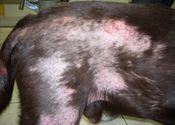Cheyletiellosis
| This article is still under construction. |
| Also known as: | Walking dandruff |
Description
A contagious disease caused by Cheyletiella sp. The mites live on the skin surface causing itching and scale on affected animals. Transmission is mainly by direct contact but the mites can also be transported between animals via a flea or lice.
A zoonotic disease.
Signalment
Occurs in dogs, cats, rabbits, humans and wild animals. There is no breed, sex or age predisposition but it is often seen in puppies probably due to management reasons.
Diagnosis
A diagnosis can be made on history and clinical signs in combination with demonstration of the parasite. Scurf can be brushed onto dark paper and 'Walking dandruff' will be seen as mites will move when present in large numbers.
The parasite can also be identified microscopically from skin scrapings, coat brushes and hair plucking form scaly areas. Eggs may also be present on the animal which can be examined microscopically.
Clinical Signs
Sometimes cases may be asymptomatic. In dogs hyperkeratosis of the skin occurs and dry, white, scaly dandruff can be seen along the back of the animal.
Marked pruritus is sometimes present which in severe cases can be confused as neurological disease. In cats pruritus is also a common feature with the presence of scale and papules. Miliary dermatitis is a commmon finding normally on the neck or back of the cat.
Pathology
Grossly: Focal, multifocal or generalised red papules or crusts occur often along the dorsum of the animal. Microscopically: Superficial perivascular dermatitis is present with infiltrating eosinophils.
Treatment
All in contact animals should be treated. The environment the animal has been living in should be cleaned and also treated. Amitraz (Aludex), baths for 3-5 weeks or selenium sulphide shampoos are effective against the mite. Ivermectin is also good when used three times two weeks apart. Fipronil spray (Frontline)is also useful as it helps remove an infestation when used in combination with other treatments.
If the animal has any secondary skin pyoderma following intense scratching this should also be treated with antibiotics.
Prognosis
Good, will resolve with treatment as long as the animal does not become re-infested.
References
Foster A.P and Foil C.S (2003) BSAVA manual of Small Animal Dermatology. 2nd edition. BSAVA.
